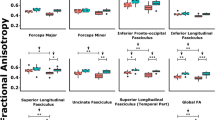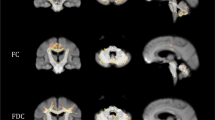Abstract
Background
Friedreich ataxia is an inherited neurodegenerative disease, with cerebral and cerebellar pathology evident. Despite an increased understanding of its neuropathology, disease progression in this disease remains poorly understood. This study aimed to characterise longitudinal change in brain structure using a multi-modal approach across cerebral and cerebellar grey and white matter.
Methods
T1-weighted, diffusion-tensor, and magnetisation transfer magnetic resonance images were obtained from 28 individuals with Friedreich ataxia and 29 age- and gender-matched controls at two time-points, 2 years apart. Region-of-interest and exploratory between-group comparisons assessed changes in brain macrostructure (cerebellar lobule volume, cerebral cortical thickness/gyrification, brain white matter volume) and microstructure (white matter fractional anisotropy, mean/axial/radial diffusivity, magnetisation transfer ratio). Rates of change were correlated against change in neurological severity, Time 1 severity, and onset age.
Results
Individuals with Friedreich ataxia had a greater rate of white matter volume loss than controls in the superior cerebellar peduncles and right peri-thalamic/posterior cerebral regions, and greater reduction in left primary motor cortex gyrification. Greater cerebellar/brainstem white matter volume loss and right dorsal premotor gyrification loss was observed amongst individuals with less severe neurological symptoms at Time 1. Conversely, cerebral atrophy and changes in axial diffusivity were observed in individuals with more severe Time 1 symptoms. Progression in radial diffusivity was more pronounced amongst individuals with earlier disease onset. Greater right ventral premotor gyrification loss correlated with greater neurological progression.
Conclusion
Heterogeneity in Friedreich ataxia progression is observed at the neurobiological level, with evidence of earlier cerebellar and later cerebral degeneration.




Similar content being viewed by others
Availability of data and material
The data that support the findings of this study are available on request from the corresponding author. The data are not publicly available due to privacy and ethical restrictions.
References
Campuzano V, Montermini L, Pianese L et al (1996) Friedreich’s ataxia: autosomal recessive disease caused by an intronic GAA triplet repeat expansion. Science 271(5254):1423–1427
Delatycki MB, Corben LA (2012) Clinical features of Friedreich ataxia. J Child Neurol 27(9):1133–1137
Delatycki MB, Paris DB, Gardner RJ et al (1999) Clinical and genetic study of Friedreich ataxia in an Australian population. Am J Med Genet 87(2):168–174
Subramony SH, May W, Lynch D et al (2005) Measuring Friedreich ataxia: Interrater reliability of a neurologic rating scale. Neurology 64(7):1261–1262
Schmitz-Hubsch T, du Montcel ST, Baliko L et al (2006) Scale for the assessment and rating of ataxia: development of a new clinical scale. Neurology 66(11):1717–1720
Campuzano V, Montermini L, Lutz Y et al (1997) Frataxin is reduced in Friedreich ataxia patients and is associated with mitochondrial membranes. Hum Mol Genet 6(11):1771–1780
Patel M, Isaacs CJ, Seyer L et al (2016) Progression of Friedreich ataxia: quantitative characterization over 5 years. Ann Clin Transl Neurol 3(9):684–694
Tai G, Corben LA, Gurrin L et al (2015) A study of up to 12 years of follow-up of Friedreich ataxia utilising four measurement tools. J Neurol Neurosurg Psychiatry 86(6):660–666
Friedman LS, Farmer JM, Perlman S et al (2010) Measuring the rate of progression in Friedreich ataxia: implications for clinical trial design. Mov Disord 25(4):426–432
Lecocq C, Charles P, Azulay J-P et al (2016) Delayed-onset Friedreich’s ataxia revisited: the delayed-onset Friedreich’s Ataxia revisited. Mov Disord 31(1):62–69
Selvadurai LP, Harding IH, Corben LA, Georgiou-Karistianis N (2018) Cerebral abnormalities in Friedreich ataxia: a review. Neurosci Biobehav Rev 84:394–406
Della Nave R, Ginestroni A, Giannelli M et al (2008) Brain structural damage in Friedreich’s ataxia. J Neurol Neurosurg Psychiatry 79(1):82–85
Della Nave R, Ginestroni A, Tessa C et al (2008) Brain white matter tracts degeneration in Friedreich ataxia. An in vivo MRI study using tract-based spatial statistics and voxel-based morphometry. Neuroimage 40(1):19–25
França MC, D’Abreu A, Yasuda CL et al (2009) A combined voxel-based morphometry and 1H-MRS study in patients with Friedreich’s ataxia. J Neurol 256(7):1114–1120
Lindig T, Bender B, Kumar VJ et al (2019) Pattern of cerebellar atrophy in Friedreich’s ataxia-using the SUIT template. Cerebellum 18(3):435–447
Pagani E, Ginestroni A, Della Nave R et al (2010) Assessment of brain white matter fiber bundle atrophy in patients with Friedreich ataxia. Radiology 255(3):882–889
Rezende TJR, Silva CB, Yassuda CL et al (2016) Longitudinal magnetic resonance imaging study shows progressive pyramidal and callosal damage in Friedreich’s ataxia: VBM, DTI, and freesurfer analysis in FRDA. Mov Disord 31(1):70–78
Selvadurai LP, Harding IH, Corben LA et al (2016) Cerebral and cerebellar grey matter atrophy in Friedreich ataxia: the IMAGE-FRDA study. J Neurol 263(11):2215–2223
Akhlaghi H, Corben L, Georgiou-Karistianis N et al (2011) Superior cerebellar peduncle atrophy in Friedreich’s ataxia correlates with disease symptoms. Cerebellum 10(1):81–87
Della Nave R, Ginestroni A, Diciotti S et al (2011) Axial diffusivity is increased in the degenerating superior cerebellar peduncles of Friedreich’s ataxia. Neuroradiology 53(5):367–372
Dogan I, Tinnemann E, Romanzetti S et al (2016) Cognition in Friedreich’s ataxia: a behavioral and multimodal imaging study. Ann Clin Transl Neurol 3(8):572–587
Rizzo G, Tonon C, Valentino ML et al (2011) Brain diffusion-weighted imaging in Friedreich’s ataxia: DWI in FRDA. Mov Disord 26(4):705–712
Corben LA, Kashuk SR, Akhlaghi H et al (2014) Myelin paucity of the superior cerebellar peduncle in individuals with Friedreich ataxia: an MRI magnetization transfer imaging study. J Neurol Sci 343(1–2):138–143
Mascalchi M, Toschi N, Giannelli M et al (2016) Regional cerebral disease progression in Friedreich’s Ataxia: a longitudinal diffusion tensor imaging study. J Neuroimaging 26(2):197–200
Ward PGD, Harding IH, Close TG et al (2019) Longitudinal evaluation of iron concentration and atrophy in the dentate nuclei in Friedreich ataxia. Mov Disord 34(3):335–343
Harding IH, Corben LA, Storey E et al (2016) Fronto-cerebellar dysfunction and dysconnectivity underlying cognition in Friedreich ataxia: the IMAGE-FRDA study: cognitive networks in Friedreich ataxia. Hum Brain Mapp 37(1):338–350
Harding IH, Corben LA, Delatycki MB et al (2017) Cerebral compensation during motor function in Friedreich ataxia: the IMAGE-FRDA study. Mov Disord 32(8):1221–1229
Harding IH, Raniga P, Delatycki MB et al (2016) Tissue atrophy and elevated iron concentration in the extrapyramidal motor system in Friedreich ataxia: the IMAGE-FRDA study. J Neurol Neurosurg Psychiatry 87(11):1261–1263
Selvadurai LP, Corben LA, Delatycki MB et al (2020) Multiple mechanisms underpin cerebral and cerebellar white matter deficits in Friedreich ataxia: the IMAGE-FRDA study. Hum Brain Mapp 41(7):1920–1933
Shishegar R, Harding IH, Corben LA et al (2020) Longitudinal Increases in cerebral brain activation during working memory performance in Friedreich ataxia: 24-month data from IMAGE-FRDA. Cerebellum 19(2):182–191
Romero JE, Coupé P, Giraud R et al (2017) CERES: a new cerebellum lobule segmentation method. Neuroimage 147:916–924
Reuter M, Schmansky NJ, Rosas HD, Fischl B (2012) Within-subject template estimation for unbiased longitudinal image analysis. Neuroimage 61(4):1402–1418
Schaer M, Cuadra MB, Tamarit L et al (2008) A surface-based approach to quantify local cortical gyrification. IEEE Trans Med Imaging 27(2):161–170
Desikan RS, Ségonne F, Fischl B et al (2006) An automated labeling system for subdividing the human cerebral cortex on MRI scans into gyral based regions of interest. Neuroimage 31(3):968–980
Keihaninejad S, Zhang H, Ryan NS et al (2013) An unbiased longitudinal analysis framework for tracking white matter changes using diffusion tensor imaging with application to Alzheimer’s disease. Neuroimage 72:153–163
Smith SM (2002) Fast robust automated brain extraction. Hum Brain Mapp 17(3):143–155
Jenkinson M, Smith S (2001) A global optimisation method for robust affine registration of brain images. Med Image Anal 5(2):143–156
Jenkinson M, Bannister P, Brady M, Smith S (2002) Improved optimization for the robust and accurate linear registration and motion correction of brain images. Neuroimage 17(2):825–841
Mayka MA, Corcos DM, Leurgans SE, Vaillancourt DE (2006) Three-dimensional locations and boundaries of motor and premotor cortices as defined by functional brain imaging: a meta-analysis. Neuroimage 31(4):1453–1474
Vavla M, Arrigoni F, Nordio A et al (2018) Functional and structural brain damage in Friedreich’s ataxia. Front Neurol 9:747
Vieira Karuta SC, Raskin S, de Carvalho NA et al (2015) Diffusion tensor imaging and tract-based spatial statistics analysis in Friedreich’s ataxia patients. Parkinsonism Relat Disord 21(5):504–508
Janve VA, Zu Z, Yao S-Y et al (2013) The radial diffusivity and magnetization transfer pool size ratio are sensitive markers for demyelination in a rat model of type III multiple sclerosis (MS) lesions. Neuroimage 74:298–305
Sun S-W, Liang H-F, Trinkaus K et al (2006) Noninvasive detection of cuprizone induced axonal damage and demyelination in the mouse corpus callosum. Magn Reson Med 55(2):302–308
Schwartz CG, Reid RI, Gunter JL et al (2014) Improved DTI registration allows voxel-based analysis that outperforms tract-based spatial statistics. Neuroimage 94:65–78
Matsuda Y, Ohi K (2018) Cortical gyrification in schizophrenia: current perspectives. Neuropsychiatr Dis Treat 14:1861–1869
Langer N, Hänggi J, Müller NA et al (2012) Effects of limb immobilization on brain plasticity. Neurology 78(3):182–188
Rezende TJR, Martinez ARM, Faber I et al (2017) Structural signature of classical versus late-onset Friedreich’s ataxia by multimodality brain MRI: neuroimaging findings in cFRDA and LOFA. Hum Brain Mapp 38(8):4157–4168
Blair IA, Farmer J, Hersch S et al (2019) The current state of biomarker research for Friedreich’s ataxia: a report from the 2018 FARA biomarker meeting. Future Sci OA 5(6):FSO398
Acknowledgements
The authors thank the individuals with Friedreich ataxia and the control participants who took part in the study, and Monique Stagnitti for participant recruitment and scanning.
Funding
The IMAGE-FRDA study was funded by the Australian National Health and Medical Research Council (Project Grant 1046037).
Author information
Authors and Affiliations
Contributions
Study conception and design were conducted by NG-K, GFE, MBD, and LAC. Data processing and statistical analyses were conducted by LPS, RS, and IHH. Additional data processing was conducted by CS. The first draft of the manuscript was written by LPS and all authors reviewed, critiqued, and edited subsequent versions of the manuscript. All authors approved the final manuscript.
Corresponding author
Ethics declarations
Conflicts of interest
On behalf of all authors, the corresponding author states that there is no conflict of interest.
Supplementary Information
Below is the link to the electronic supplementary material.
Rights and permissions
About this article
Cite this article
Selvadurai, L.P., Georgiou-Karistianis, N., Shishegar, R. et al. Longitudinal structural brain changes in Friedreich ataxia depend on disease severity: the IMAGE-FRDA study. J Neurol 268, 4178–4189 (2021). https://doi.org/10.1007/s00415-021-10512-x
Received:
Revised:
Accepted:
Published:
Issue Date:
DOI: https://doi.org/10.1007/s00415-021-10512-x




